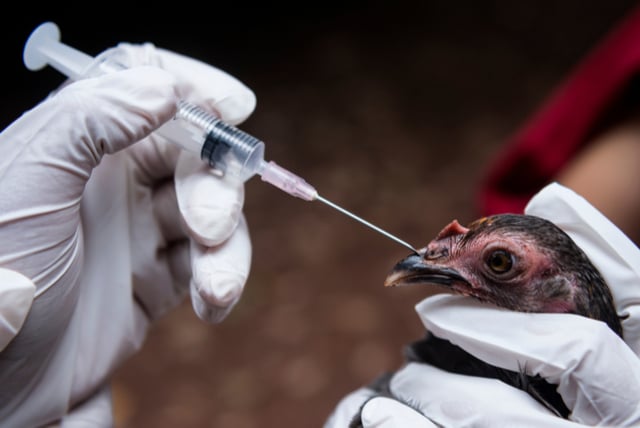The Issues
A Hazard to Human Health

Photo: Stasia04/shutterstock.com
In the U.S., almost ten billion animals are exploited and slaughtered every year. Most live short miserable lives in overcrowded factory farms, which are a breeding ground for disease, including emerging pathogens and virulent strains of antibiotic-resistant bacteria. The unnatural feeds, hormones, and excessive quantities of antibiotics used put the human population at risk for chronic disease, obesity, and drug-resistant bacteria, and pose the threat of major zoonotic disease outbreaks.
The Centers for Disease Control and Prevention (CDC) warns: “…3 out of every 4 new or emerging infectious diseases in people come from animals.” These include viruses, bacteria, fungi and parasites, and they infect millions of U.S. citizens every year.
A vegan or plant-based diet can have innumerable health benefits and is supported by organizations like the USDA and Academy for Nutrition and Dietetics. Vegans enjoy lower blood pressure, lower cholesterol, and a lower risk of heart disease, type 2 diabetes and certain cancers.

Photo: morinka/shutterstock.com
Facts
Animal Agriculture Doesn't Just Hurt Animals

Photo: Lano Lan/shutterstock.com
Some diseases, such as H1N1 (swine flu), SARS and MERS (avian flu), and COVID-19 are communicable from animals to humans. These “zoonotic” diseases have the potential to become pandemics. The Centers for Disease Control and Prevention (CDC) warns: “…3 out of every 4 new or emerging infectious diseases in people come from animals.” These include viruses, bacteria, fungi and parasites, and they infect millions of U.S. citizens every year.
Experts believe that the outbreak of H1N1 was likely caused by the overcrowding of pigs on factory farms and the storage of their waste in giant manure lagoons.

Photo: Lano Lan/shutterstock.com
Some diseases, such as H1N1 (swine flu), SARS and MERS (avian flu), and COVID-19 are communicable from animals to humans. These “zoonotic” diseases have the potential to become pandemics. The Centers for Disease Control and Prevention (CDC) warns: “…3 out of every 4 new or emerging infectious diseases in people come from animals.” These include viruses, bacteria, fungi and parasites, and they infect millions of U.S. citizens every year.
Experts believe that the outbreak of H1N1 was likely caused by the overcrowding of pigs on factory farms and the storage of their waste in giant manure lagoons.

Photo: docter_k/shutterstock.com
Since the 1950s, antibiotics have been used on factory farms to increase the rate of growth in animals. In 2018, the animal agriculture industry purchased 25 million pounds of antibiotics. Fifty-two percent of those were antibiotics important to human health. Using antibiotics in this way can lead to drug-resistant bacteria; as a result, certain bacterial infections have already become or are on their way to becoming untreatable in humans. Antibiotic-resistant infections kill 35,000 Americans every year.

Photo: docter_k/shutterstock.com
Poor sanitation and waste management on factory farms can lead to the contamination of the food supply by bacteria such as E. coli and Salmonella. Each year 48 million Americans become ill from foodborne illness, and thousands die.

Photo: Thaiview/shutterstock.com
Cows in the dairy industry can be given growth hormones in order to increase their milk production. Once their productivity declines, these cows are slaughtered for beef. The six growth hormones commonly used by the U.S. dairy industry have been shown to significantly increase the risk of breast, prostate, and colon cancer in beef consumers. Producers are not required to list the use of hormones on product labels.

Photo: Andrey_Popov/shutterstock.com
According to the Centers for Disease Control and Prevention, animal products are the primary source of saturated fat in the American diet. Saturated fat has been linked to heart disease and obesity. There is evidence suggesting that the unnatural feeds used to promote growth in animals on factory farms increase the saturated fat content of meat.
What Can We Do?

Photo: Nattakorn_Maneerat/shutterstock.com
The more plant-based foods you start adding to your diet the healthier you will become! A vegan or plant-based diet can have innumerable health benefits and is supported by organizations like the USDA and Academy for Nutrition and Dietetics. Vegans enjoy lower blood pressure, lower cholesterol, and a lower risk of heart disease, type 2 diabetes and certain cancers.
Want to extend the love? Growing community gardens can help keep community members healthy, increase food security, and boost nearby property values. It’s empowering to nourish our bodies with living foods that we can grow in our homes or communities!
Check out our plant-based eating guide at the link below and find out how delicious and fulfilling a vegan diet can be.











